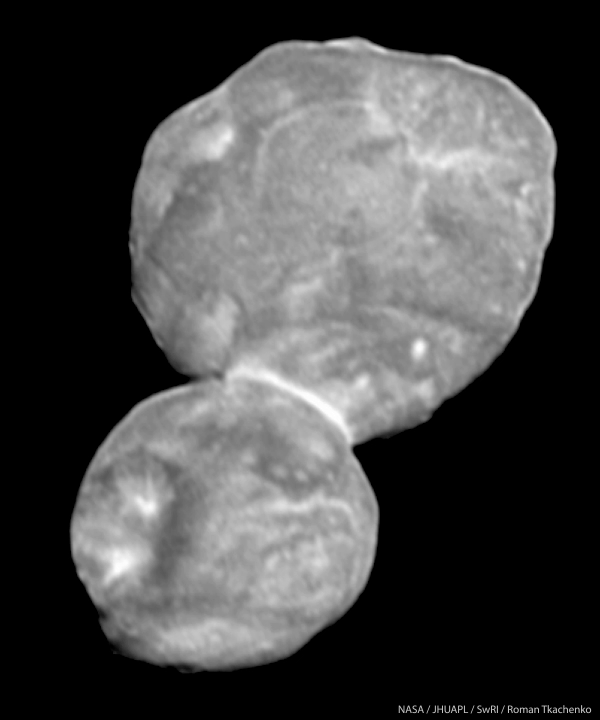The space snowman that was the focus of a close encounter with NASA's New Horizons probe last year is helping scientists answer a cosmic question: How did the building blocks of the solar system get their start?
"This is a game-changer," said Alan Stern, a planetary scientist at the Southwest Research Institute and principal investigator for the New Horizons mission.
Stern and other members of the New Horizons science team shared their latest findings about the snowman-shaped object now known as Arrokoth today at the American Association for the Advancement of Science's annual meeting in Seattle. Those findings are detailed in a trio of studies published by the journal Science.
The biggest revelation has to do with Arrokoth's ancient origins.
A detailed analysis of the object's double-lobed, snowman-like structure supports the view that Arrokoth came into existence when a localized cloud of primordial material collapsed into two nearby clumps that gently fused together.
That's in contrast to an alternate view, known as hierarchical accretion, which proposes that objects from different parts of the early solar system smashed together to form planetesimals like Arrokoth.
The studies released today follow up on first-look reports that were published in Science last May. The updated view presented by the scientists today is based on an analysis of 10 times as much data as they had available back then.
New Horizons was launched back in 2006 and got an unprecedented look at Pluto as it flew past in 2015. Arrokoth, which is a billion miles beyond Pluto, was chosen as the piano-sized probe's next target for observation. It's thought to be representative of the small mini-planets that took shape during the collapse of the solar nebula, the vast cloud of gas and dust that surrounded our infant sun.
With New Horizons' encounter with Arrokoth on New Year's Day of 2019, the space snowman became the farthest-out celestial object to be observed close up. The science team was wowed by the data that trickled back in the first months after the encounter, but they still had some mysteries to sort out.

Scientists now say several new clues have led them to the conclusion that Arrokoth's two constituent pieces formed in the same neighborhood of the primordial solar system and came together gently.
First of all, the two lobes have closely aligned poles and equators, and there's no evidence of a high-speed smash-up. "Only at much lower collision velocities, substantially less than the mutual escape speed, and at an oblique angle, do the outcomes of our simulations begin to resemble Arrokoth," the New Horizon scientists wrote in one of their research papers.
The simulations suggest that Arrokoth's two halves came together at a speed of 7 mph or less. "They're just kissing," William McKinnon, a planetary scientist at Washington University of St. Louis, explained at today's briefing. "If they were spacecraft, they'd be docking."
Another clue came from the uniformity of the object's spectral signature. Both lobes are unusually red in color, and spectral analysis suggests the strong presence of methanol ice. The fact that the two lobes are chemically homogeneous serves as further evidence that they formed in close proximity.
"It's drawing basically from locally sourced materials all at once," Lowell Observatory's Will Grundy said.
McKinnon said the cloud-collapse scenario would explain how the solar system got such a fast start 4.5 billion years ago. "It jump-starts planet formation," he said.
Planetesimals like Arrokoth almost certainly served as the seeds for growing bigger worlds, including terrestrial planets like Earth and gas giants like Jupiter, the scientists said.
A 3-D reconstruction of Arrokoth's shape indicates that the larger lobe measures 12.8 by 12.3 wide and 5.8 miles thick, while the smaller lobe is 9.6 by 8.6 miles wide and 6.1 miles thick. Those dimensions make the snowman look more like a squashed bug — but overall, it's not as squashed as scientists assumed it was last year. Arrokoth's volume is now estimated to be 30% larger than previously thought.
Today New Horizons is more than 315 million miles beyond Arrokoth and zooming outward through the Kuiper Belt, the icy ring of material on the solar system's edge. It's expected to keep sending back scientific data about Arrokoth for another year.
In the meantime, New Horizons' scientists will be using time on ground-based telescopes to search for more distant Kuiper Belt objects that could be candidates for a future flyby. Within the next year or two, they hope to identify a third way-out world that's ready for its close-up.
The three Science studies are "The Geology and Geophysics of Kuiper Belt Object (486958) Arrokoth," with John Spencer of the Southwest Research Institute as first author; "The Solar Nebula Origin of (486958) Arrokoth, a Primordial Contact Binary in the Kuiper Belt," with William McKinnon of Washington University in St. Louis as first author; and "Color, Composition and Thermal Environment of Kuiper Belt Object (486958) Arrokoth," with Will Grundy of the Lowell Observatory as first author.
This story was originally published in GeekWire. Love space and science? Sign up for GeekWire's Space & Science email newsletter.

